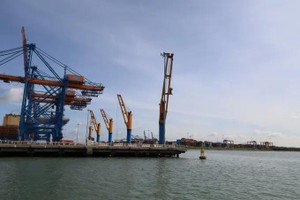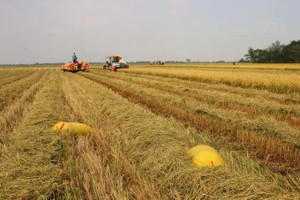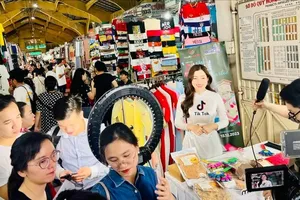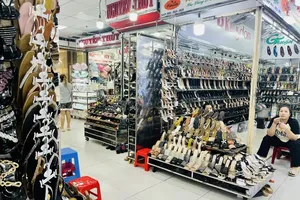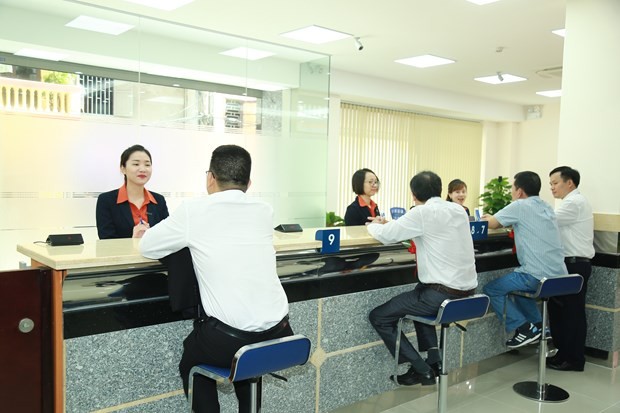 Customers make transactions at a Sacombank office.
Customers make transactions at a Sacombank office.
Saigon Thuong Tin Commercial Joint Stock Bank (Sacombank) has not yet resumed lending to the real estate sector, except for the bank’s employees and relatives to buy, build or repair real estate for living purposes, since the bank announced the suspension of home loans for individual customers in early April 2022.
According to Sacombank’s leaders, the bank has focused on lending to manufacturing sectors, prioritized sectors, including agriculture, rural areas, export, supporting industries, small and medium-sized enterprises, high-tech enterprises, trade and service industries with high added value such as export, service and logistics.
Sacombank and many other banks have suspended real estate lending, including individual home loans.
Trinh Bang Vu, head of Shinhan Bank Vietnam’s loan division, said as the bank used up most of the credit quota granted by the State Bank of Vietnam (SBV), it is currently suspending disbursement for individuals to buy houses.
Previously, Shinhan Vietnam was considered one of the foreign banks in Vietnam applying the most competitive interest rates for home loans, at about 6-8 percent per year.
A leader of another bank said his bank had stopped disbursing real estate loans since the end of March 2022 to meet the SBV’s regulations on credit growth. Since then, the bank has focused on lending for production and business.
According to the SBV, by the end of April 2022, banks’ total outstanding loans to the real estate sector reached more than VND2.28 quadrillion, up 10.2 percent compared to the end of 2021 and accounting for 20.44 percent of total outstanding loans in the economy.
SBV’s deputy governor Dao Minh Tu said SBV found some banks funded large amounts of consumer loans that were related to real estate to individual customers, which had many potential risks if there was a sharp decline in the real estate market.
In the second half of 2022, many uncertainties are unfavorable for the economy. Therefore, the central bank will combine flexibly fiscal and monetary policies to ensure market capital supply and control inflation.
SBV will aim to disburse loans to prioritized areas to help firms return to normal production and business as before the pandemic, and rebound the economy besides strengthening the control of high-risk sectors such as securities and real estate.
Nguyen Quoc Hung, general secretary of the Vietnam Banks Association (VNBA), said up to 70 percent of collateral assets at banks are currently real estate, so banks will be the most vulnerable if the real estate market declines if they continue to lend the industry.
Meanwhile, finance and banking expert Dinh The Hien said the credit growth rate of more than 10 percent per year in the real estate sector was not worrisome, and it still needed to be strictly controlled to direct loans to the residential sector with real needs but not the speculative segment.
According to Sacombank’s leaders, the bank has focused on lending to manufacturing sectors, prioritized sectors, including agriculture, rural areas, export, supporting industries, small and medium-sized enterprises, high-tech enterprises, trade and service industries with high added value such as export, service and logistics.
Sacombank and many other banks have suspended real estate lending, including individual home loans.
Trinh Bang Vu, head of Shinhan Bank Vietnam’s loan division, said as the bank used up most of the credit quota granted by the State Bank of Vietnam (SBV), it is currently suspending disbursement for individuals to buy houses.
Previously, Shinhan Vietnam was considered one of the foreign banks in Vietnam applying the most competitive interest rates for home loans, at about 6-8 percent per year.
A leader of another bank said his bank had stopped disbursing real estate loans since the end of March 2022 to meet the SBV’s regulations on credit growth. Since then, the bank has focused on lending for production and business.
According to the SBV, by the end of April 2022, banks’ total outstanding loans to the real estate sector reached more than VND2.28 quadrillion, up 10.2 percent compared to the end of 2021 and accounting for 20.44 percent of total outstanding loans in the economy.
SBV’s deputy governor Dao Minh Tu said SBV found some banks funded large amounts of consumer loans that were related to real estate to individual customers, which had many potential risks if there was a sharp decline in the real estate market.
In the second half of 2022, many uncertainties are unfavorable for the economy. Therefore, the central bank will combine flexibly fiscal and monetary policies to ensure market capital supply and control inflation.
SBV will aim to disburse loans to prioritized areas to help firms return to normal production and business as before the pandemic, and rebound the economy besides strengthening the control of high-risk sectors such as securities and real estate.
Nguyen Quoc Hung, general secretary of the Vietnam Banks Association (VNBA), said up to 70 percent of collateral assets at banks are currently real estate, so banks will be the most vulnerable if the real estate market declines if they continue to lend the industry.
Meanwhile, finance and banking expert Dinh The Hien said the credit growth rate of more than 10 percent per year in the real estate sector was not worrisome, and it still needed to be strictly controlled to direct loans to the residential sector with real needs but not the speculative segment.






